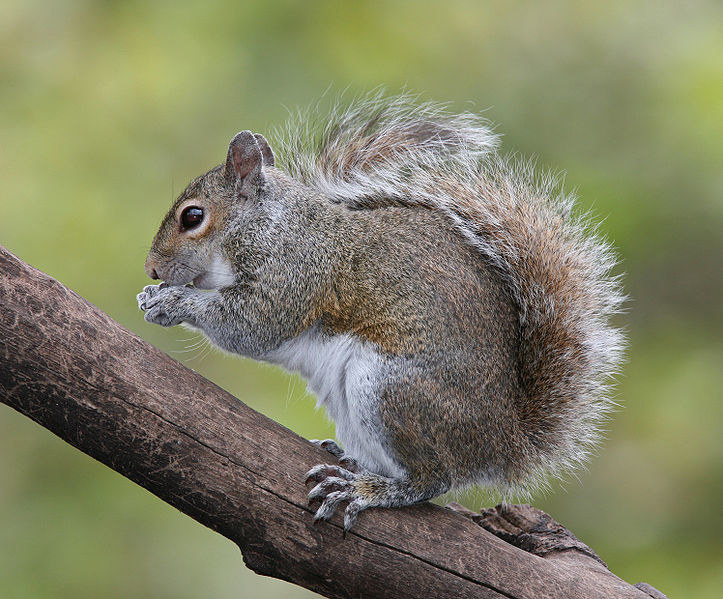
Red squirrels on an island in the West Country have got leprosy, and have probably had it since it was common among humans in Britain during the Middle Ages.
The squirrels are infected with a strain of bacteria that is closely related to one found in the skeleton of a leprosy victim who was buried in Winchester, just 45 miles from Brownsea Island where they live, 730 years ago.
“It’s quite a staggering fact that now you find this strain from the Middle Ages in these squirrels on Brownsea Island,” said Professor Stewart Cole, a microbiologist at École Polytechnique Fédérale de Lausanne in Switzerland and author of a study into the squirrels, published in the journal Science on Thursday.
“What that shows is that a human pathogen, even after it’s disappeared from human circulation, can remain undetected in an animal reservoir and so has the potential to re-emerge later on.”
An "animal reservoir" is a group of animals that can harbour an infection, often without getting the disease themselves, or at least not showing symptoms.
Cole told BuzzFeed News that the discovery poses no major risk to humans, but rangers who work on the island should be offered tests to see if they’ve been exposed.
The study also found that other red and grey squirrels from Britain and Ireland are infected with a different bacteria that most commonly causes leprosy in animals. Only four grey squirrels were included in the study, so scientists can’t yet say anything about the wider prevalence of leprosy in Britain’s grey squirrel population as a whole.
Leprosy is caused by two different, but closely related, bacteria: Mycobacterium leprae and Mycobacterium lepromatosis. The bacterium M. leprae causes the main human form of the disease, whereas M. lepromatosis is usually found in animals.
Leprosy caused by M. leprae was once common among humans in Britain, but was eradicated several hundred years ago.
A total of 110 red squirrels and four grey squirrels were tested by Cole and his colleagues. All 25 of the red squirrels from Brownsea Island, most of which had no obvious signs of disease, were infected with the M. leprae bacteria.
Of the other squirrels that Cole and his colleagues tested, six from Scotland, two from Ireland, and one from the Isle of Wight in England were infected with M. lepromatosis.
In total, only 13 of the 34 squirrels with leprosy in the study had obvious symptoms, meaning the majority of those that were infected were seemingly healthy.
Leprosy was first found in red squirrels in Scotland in 2014, and later found to also infect squirrels elsewhere in the UK. But until now it wasn’t known which of the two leprosy-causing bacteria each population of squirrels had.

Dr Caroline Millins, a veterinary pathologist at the University of Glasgow who was not involved with the study, told BuzzFeed News that this discovery could be significant for countries in which leprosy is still a problem today, if it leads them to discover other animals harbouring the disease. "While the significance of the disease for red squirrel conservation remains to be unravelled, it suggests that investigation of other potential animal reservoirs in leprosy endemic countries could be important in reducing the human burden of disease," she said.
Leprosy caused by M. leprae is also found in armadillos in the southern states of the US, where there have been incidences of transmission from animals to humans.
“In these cases people tend to hunt the animals, or catch them and eat them,” said Cole. The fact that people in the UK do not have much contact with red squirrels, and the fact that leprosy is not very contagious, he said, means that there’s no major risk of transmission from squirrels to humans in the UK. Though he added that “some attention” should be paid to the issue, particularly for people such as park rangers who may come into contact with the infected squirrels on Brownsea Island.

Red squirrels are native to Britain but their future is under threat because of loss of habitat and competition with grey squirrels that were introduced to the country from North America.
There are around 140,000 red squirrels in the UK, and more than 2.5 million grey ones. Grey squirrels are bigger and carry a virus called squirrel pox, which doesn't harm grey squirrels but is fatal to red ones.
This discovery doesn't necessarily mean that red squirrels are any more under threat than we previously believed. “If red squirrels have indeed been infected with [leprosy] for as long as this research indicates, and there is no reason to suspect that this is not the case, it would seem that overall the population can cope with the infection,” Siobhan Simpson, a PhD candidate at the University of Nottingham’s School of Veterinary Medicine and Science, who was not involved in the study, told BuzzFeed News.
She agreed that there was no real threat to people, but suggested taking sensible precautions like washing hands and wearing protective gloves to clean feeders if you get squirrels visiting your garden. "It would seem that red squirrels have been harbouring leprosy in the UK and Ireland for hundreds of years and in that time we have not had simultaneous leprosy infections in people," she said. "The general public does not need to worry."
